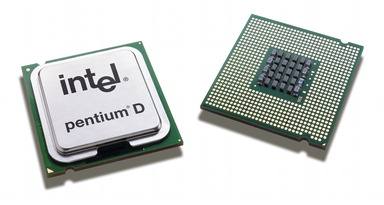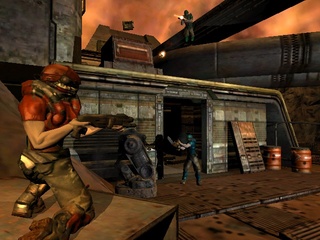|
Intel Pentium D 820 CPU Review
The next wave of processors is finally
here and Intel's Pentium D 820 dual-core processor will definitely set
the benchmark for the next generation of central processing units
(CPUs). Intel considers their Pentium D 820 CPU one of their entry level
dual-core processors that not only make it affordable to the average
computer user but also to businesses who require more than one computer.
This processor performs all tasks admirably, whether business or
leisure and not only can it run applications of today but also
applications of tomorrow with its 64-bit core and passion for
multitasking. A CPU
for today and for tomorrow!

Hyper-Threading Technology vs. Dual-core processing
Although
Hyper-Threading Technology (HTT) was a main selling point of the single-core
processors, dual-core processors are the next evolutionary step that
basically gives your computer more resources and computing throughput
that is ideal for multitasking. Or in laymen's terms, it's like having
two processors in your computer.
The
majority of current Intel single-core Pentium 4 processors are using a
modified version of the Prescott processor which has single-core
processor. The Intel 820 uses the new Smithfield processor design and
also contains a L2 cache of 2MB that is split between both cores,
enabling each core access to 1MB.
Another noticeable difference between
single-core processors is that the Smithfield design runs at a lower
clock speed than its predecessors because of heat and power
requirements. With that said, clock speeds are no longer the bee's knees
of computer performance and even though it may be running at slower
clock speeds, it basically kills the competition when multitasking is
involved. Still, with a dual-core processor, heat is still an issue that
Intel have solved with a larger cooling surface and copper sole to
ensure that overheating is not a problem.
Intel Pentium D 820 Features
|
Processor |



Intel® Pentium® D Processor |
|
Processor NumberΔ |
820 |
|
Architecture |
90 nm technology |
|
L2 Cache |
2x1MB |
|
Clock Speed |
2.80 GHz to 3.20 GHz |
|
Front Side Bus |
800 MHz |
|
Chipset |
 |
Intel® 955X Express chipset |
 |
 |
Intel® 945P Express chipset |
 |
 |
Intel® 945G Express chipset |
 |
 |
Intel® E7230 Chipset |
 |
|
|
Socket |
LGA775 |
|
Motherboard |
Intel® Desktop Boards
D955XCS,
D955XBK,
D945PSN,
D945PLM,
D945PVS,
D945PAW,
D945GNT,
D945GTP, and
D945GCZ |
|
Features |
Benefits |
|
Dual-Core |
Provides two execution cores in one physical processor allowing
the platform to do more in less time while enjoying smooth
interaction with your PC. |
|
Enhanced Intel® SpeedStep® Technology |
Enables
cooler and quieter PC designs—depending on system implementation
and usage. (Not available on 820.) |
|
Execute Disable Bit° |
Can
help to prevent some classes of viruses and worms that exploit
buffer overrun vulnerabilities thus helping to improve the
overall security of the system. |
|
Intel® Extended Memory 64 TechnologyΦ |
Processors with Intel EM64T allow platforms to access larger
amounts of memory and will support 64-bit extended operating
systems. |

Applications of today and multitasking
With the advent of dual core processors, the CPU now
doubles the number of execution units that is ideal for multitasking
which not only increases performance but also dramatically reduces
waiting time. Although in theory this ideal, unfortunately with many of
the current applications of today, the 820 is still running a little
behind of the last guard of the single-core processors.
However, it should also be mentioned that this
performance increase will not really be that noticeable until the new
operating systems and applications of 2006 are out, that will offer full
support to dual-core processors. Especially by Microsoft's new operating
system that has been eagerly anticipated.
Interestingly enough, the 820 processor
runs at a clock speed of 2.8Ghz but with the dual-core processor, it is
almost like having two CPU's in your machine, both running at 2.8Ghz
which is where this CPU shines through on multitasking applications.
Nevertheless, the 820 still performs remarkable well as an entry level
dual-core processor that almost keeps up to the big guns in both gaming
and business.
The
Future
The next stage of software that supports dual-core
processors will probably be one of the biggest changes in computing in
decades. Imagine running multiple tasks simultaneously, Microsoft Excel
calculating a huge formula, running a virus scan in the background and
playing Quake 4… this is what dual-core processors are capable of.
The 820 also
supports many similar features of the Prescott process that include:
-
64-bit EM64T
extensions support Execute Disable Bit technology
Demand Based
Switching options (C1E, TM2 and EIST technologies)
-
Pentium D 840
Clock frequency 3.2GHz Bus frequency 800MHz
L2 cache size 2
MB (1MB for each core) Hyper-Threading None
Demand Based Switching Yes
Software
tests
The
following software packages were used on the D 820 to test the power and
performance of this CPU.
-
Windows XP (Service Pack 2)
-
Business Winstone 2004
-
Doom 3
-
FarCry
-
3DMark2001
-
3DMark05
Real-world
applications simulations
Business Winstone 2004 (standard benchmark)
| Pentium 4 670 |
 (26.5)
(26.5) |
| Pentium 4 660 |
 (22.2)
(22.2) |
| Pentium D 820 |
 (19.6)
(19.6) |
Business
Winstone 2004 Multitasking test 1
| Pentium 4 670 |
 (2.28)
(2.28) |
| Pentium 4 660 |
 (2.20)
(2.20) |
| Pentium D 820 |
 (2.09)
(2.09) |
Business
Winstone 2004 Multitasking test 2
| Pentium 4 670 |
 (2.65)
(2.65) |
| Pentium 4 660 |
 (2.59)
(2.59) |
| Pentium D 820 |
 (2.50)
(2.50) |
Business
Winstone 2004 Multitasking test 3
| Pentium 4 670 |
 (3.81)
(3.81) |
| Pentium D 820 |
 (3.73)
(3.73) |
| Pentium 4 660 |
 (3.65)
(3.65) |
In order to
thoroughly test the multitasking capabilities of the 820D, we used Business
Winstone 2004 to put this CPU through the hoops.
Business
Winstone is a system-level, application-based benchmark that measures a
PC's overall performance when running Windows XP based operating systems
and is probably the closest you can get to real-world application tests.
Although there was no noticeable different in
Multitasking test 1 between the Intel 627 and Intel 820, the 820 shone
through Multitasking test 2 and 3 that handled the multitasking tests
perfectly and is once again where dual-core processors shine and was
just a tad behind the powerful single-core processors.
Gaming
Benchmarks
3DMark2001
| Pentium 4 670 |
 (27102)
(27102) |
| Pentium 4 660 |
 (26370)
(26370) |
| Pentium D 820 |
 (20239)
(20239) |
3DMark05
| Pentium 4 670 |
 (5715)
(5715) |
| Pentium 4 660 |
 (5658)
(5658) |
| Pentium D 820 |
 (5564)
(5564) |
The 3DMark series is probably the most popular CPU and
graphic benchmarking programs available that tests a variety of features
that are important to the gaming world. Although the 820 performed
slower on 3DMark2001 (which was solely designed for single-core
processors), it performed remarkable well when compared to its gigahertz
driven siblings. With that said, when games support dual-core
processors, there will be a huge difference because the CPU could have
one core performing the graphics with the other core handling sound and
artificial intelligence. And Although the 820 didn’t perform as well
as current single-core processors,
the results were nothing to scoff at it and considering that this is an
entry level dual-core processor, it held its ground quite well.
Farcry (frames per second)
| Pentium 4 670 |
 (176.2)
(176.2) |
| Pentium 4 660 |
 (169.04)
(169.04) |
| Pentium D 820 |
 (132.01)
(132.01) |
Doom 3 (frames per second)
| Pentium 4 670 |
 (96.4)
(96.4) |
| Pentium 4 660 |
 (94.31)
(94.31) |
| Pentium D 820 |
 (84.1)
(84.1) |

The
820 performed exceptionally well with Farcry but was a little sluggish
in Doom 3 that is probably one of the most graphical intensive games out
at the moment, not taking into consideration Quake 4 that also uses the
Doom engine. However, the tests of the 820 do show that this processor
can handle the games that we have thrown at it quite well and anything
over 60 frames per second is fine in our books.
Conclusion
In
conclusion, the Intel Pentium D 820 dual processor is an extremely
impressive work horse that thrives on multitask
operations A dual-core processor is indeed the future of computing and
although this processor cannot keep up with the current market of
single-core processors, in the following months when software is
available for this unit, it will soon become a dominant force in the
market.
Professional gamers should hold back awhile before they make the
jump to dual-core processors as many games are programmed for
single-threaded CPUs, so in theory, only 50% of your CPU will be
working. Recommend for all levels of business users and entry level
gamers. |